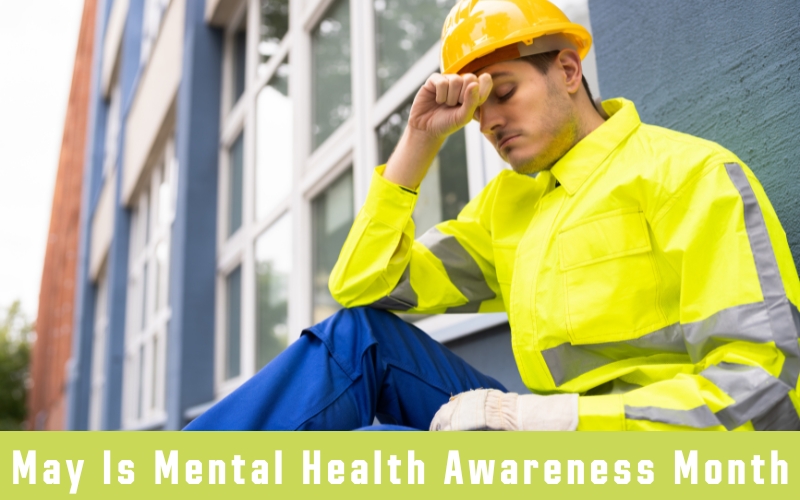As we recognize Mental Health Awareness Month in May 2025, it’s imperative to confront the silent crisis of mental health in the construction industry. As an expert in occupational safety and mental health, I’ve witnessed how the unique demands of construction—long hours, physical strain, and job insecurity—create significant mental health challenges. The construction sector faces one of the highest suicide rates among industries, with male workers four times more likely to die by suicide than the general population, according to the Centers for Disease Control and Prevention (CDC). Additionally, a 2020 survey by CPWR – The Center for Construction Research and Training found that 14.3% of construction workers struggle with anxiety and nearly 6% with depression. These statistics highlight the urgent need for action to support the well-being of our workforce.
The Unique Challenges in Construction
Construction workers face a range of stressors that contribute to mental health issues:
- Physical Demands: Labor-intensive work leads to chronic pain and fatigue, which can exacerbate mental health challenges.
- Workload and Deadlines: Long hours, often 10-12 hours daily, and tight project deadlines create immense pressure.
- Job Insecurity: Seasonal layoffs and financial instability are common, with 55% of workers attributing poor mental health to industry practices, per a study by the Construction Safety Research Alliance.
- Stigma and Cultural Barriers: The industry’s emphasis on toughness discourages help-seeking, with 78% of workers citing shame and 77% fearing peer judgment as barriers to care, according to a 2021 survey by the Center for Workplace Mental Health.
These factors contribute to a silent crisis, where mental health is often overshadowed by the focus on physical safety. However, mental health is equally critical to ensuring a safe and productive workforce.
Evidence-Based Strategies for Improvement
To address these challenges, employers and workers must adopt proactive, evidence-based strategies:
- Leadership Engagement: Leaders must champion mental health initiatives. A 2021 survey found that 77% of construction CEOs prioritize mental health, yet only 51% of workers feel their organization has a caring culture. Leaders should be visible, vocal, and vulnerable, articulating mental health as a strategic priority to reduce stigma.
- Training and Education: Providing mental health training for employees and supervisors is essential. Programs like Construction Working Minds offer resources on recognizing signs of distress, such as decreased productivity, isolation, or excessive substance use. Supervisor training is critical, as 37% of workers feel uncomfortable discussing mental health with supervisors.
- Promoting Employee Assistance Programs (EAPs): EAPs provide confidential counseling and support, yet only 63% of construction companies offer them, and many workers are unaware of how to access them. Employers must actively promote EAPs, ensuring workers know how to reach out without fear of negative job consequences. If your employer provides an EAP, contact them for support—it’s a resource designed to help you.
- Creating a Supportive Culture: Foster psychological safety through open discussions about mental health. OSHA’s Toolbox Talks are free resources that encourage workers to share experiences and learn about mental health. Newsletters, posters, and peer support programs can further build a sense of belonging.
- Addressing Stigma: Challenge the notion that seeking help is a weakness. Promote the idea that mental health care is as vital as physical safety. Initiatives like the “STAND Up” pledge by the Construction Industry Alliance for Suicide Prevention encourage a culture of support and compassion.
Taking Action: A Call to Workers and Employers
If you’re struggling, you are not alone. Reach out to your employer’s EAP for confidential support or talk to a trusted colleague or supervisor. These programs are designed to help you navigate challenges without judgment. If an EAP is not available, contact the National Suicide Prevention Hotline at 988 or the Crisis Text Line by texting HOME to 741741. Seeking help is a sign of strength, not weakness.
Employers have a responsibility to create a supportive environment. Invest in evidence-based initiatives, such as mental health training and EAP promotion, and evaluate their impact through metrics like job satisfaction and employee engagement. By addressing work-related stressors like financial instability and excessive workloads, companies can reduce the mental health burden on workers.
A Vision for a Healthier Industry
Mental health is not just a personal issue—it’s a workplace safety priority. As we build the infrastructure of our world, we must also build a culture that values the well-being of every worker. This Mental Health Awareness Month, let’s commit to breaking the stigma, promoting resources like EAPs, and fostering a supportive industry where every worker feels valued and heard. Together, we can create a stronger, safer, and more resilient construction workforce.
A Vision for a Healthier Industry
Mental health is not just a personal issue—it’s a workplace safety priority. As we build the infrastructure of our world, we must also build a culture that values the well-being of every worker. This Mental Health Awareness Month, let’s commit to breaking the stigma, promoting resources like EAPs, and fostering a supportive industry where every worker feels valued and heard. Together, we can create a stronger, safer, and more resilient construction workforce.
Citations
- CDC: Suicide Rates in Construction Industry
- OSHA Toolbox Talks for Safety and Health
- Construction Working Minds: Mental Health Resources
- Construction Industry Alliance for Suicide Prevention
- National Suicide Prevention Lifeline
- Crisis Text Line: Support for Mental Health
- SAMHSA Mental Health Awareness Month Toolkit
- Center for Workplace Mental Health: Construction Industry Survey
- CDC: Suicide Rates in Construction Industry
- OSHA Toolbox Talks for Safety and Health
- Construction Working Minds: Mental Health Resources
- Construction Industry Alliance for Suicide Prevention
- National Suicide Prevention Lifeline
- Crisis Text Line: Support for Mental Health
- SAMHSA Mental Health Awareness Month Toolkit
- Center for Workplace Mental Health: Construction Industry Survey

